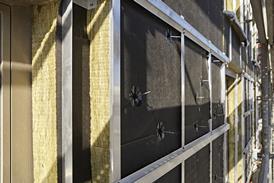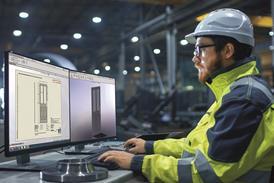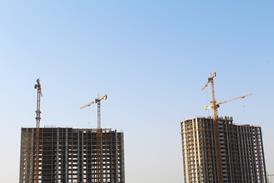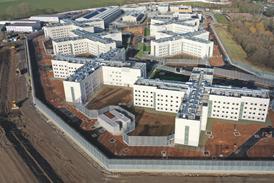The brief
The main objective of the project was to create large open plan design studios to accommodate the practice's growing business. In addition, it was decided to create a reception area that would become the new front of house for the site. The reception, or 'moderator building' – as named by architects Design Engine - is a double height entrance area, providing a view into the main studio building as well as the new lower ground café area and gardens, and is overlooked by a balcony that leads to a 30 seat training room. Pettifer says the reception space was important in linking the hugely varied appearance of old and new buildings: "The reception acts as a buffer between the differing architectural styles of the original brick built house and the modern cedar clad facades of the studios."
The commercial green principles were considered by the architect throughout and it was stipulated that materials from re-cycled or sustainable managed sources would be given priority, that walls, floor and roof would be super insulated to minimise heat loss, and that high performance glazing would be utilised sparingly to control thermal impact while providing natural daylight. The brief also stated that exposed thermal mass in conjunction with night cooling was to be used to help attenuate internal temperature variation. Best practice was to be achieved for airtightness and a highly efficient structural solution with low embodied energy was required. As well as the main office areas on the ground and first floor, each also has three cellular offices for senior members of staff or for use as bookable meeting rooms.
Building fabric
The building fabric was developed in tandem with the building services strategy and the team decided as a result to install a fully accessible raised access floor as the primary means of services distribution. "We paid a lot of attention to the envelope and the building fabric itself so that we are minimising the impact of the external environment on the internal, which means that you can then have a much lighter touch on the way you service the building," says Pettifer. The external walls comprise a 'breathing wall' construction made up of an external cedar rainscreen cladding and a sandwich of Panelvent panels on the outside, Stirling board on the inside and a 300 mm deep filling of Warmcell, an insulation made from recycled newspaper, achieving a U value of 0.1 W/m2°C. The depth of the insulation allows for the steel columns that support the first floor to be totally encased by the wall for a cleaner look to the internal spaces. The majority of the ground floor is an in-situ concrete slab except the area above the lower ground floor where pre-cast planks have been used. The first floor is a flat slab comprising pre-cast planks with a post-tensioned in-situ topping. "The post-tensioning cables are set into ducts within the concrete. You pour the concrete and then pull the cables tight and it pulls the concrete into compression," says Pettifer. "Concrete works very well in compression and poorly in tension so you're changing the forces within the concrete and that has allowed us to have a very slim structure. As a result there are very few columns in the building and there's a wide spacing between them – 9.6m as opposed to 6m to 7.5m in a conventional building."
Windows are located sparingly on the ground floor. The idea is to limit conductive heat losses and solar heat gains while having enough of them to create visual interest and provide natural light. One of the larger areas of glazing is on the ground floor south side of the building, but the threat of high solar gain is avoided by a large over hang, which also provides another space for outdoor seating. Pettifer says: "In a conventional commercial office you'd have windows all the way round but we didn't feel we needed that.
"Architecturally you can create a more interesting environment by providing pools of natural light." The windows are argon filled low-e double glazing , giving a U value of around 1.3W/m2°C with a timber frame and aluminium facing on the outside. The first floor has a saw tooth roof profile with extensive north lights installed to achieve a substantially daylit environment. Wall glazing is again kept to a minimum, mostly in the guise of pillar box style windows at seated eye level to provide views out. The exposed sloping soffits created by the saw tooth roof are finished with two layers of Fermacell, a high-density plasterboard. "We didn't form them in concrete because of the high cost but we wanted to get some of the benefit of exposed thermal mass. We call this a 'mass-improved' roof," explains Pettifer.
Mechanical services
The mixed mode ventilation system is very low energy, with opening windows supplemented by low pressure fans situated under the raised floor drawing air in through the cedar cladding. The fans push fresh air into the floor voids which act as supply air plenums and distributes into the office space through floor mounted swirl diffusers. Total power consumed at full speed is 440W for all of these fans. The concrete floor and exposed concrete soffit also allow the thermal mass of the building to keep the space cool with the use of cool night air, as Pettifer explains: "We can turn the underfloor fans on at night and pass air through the building. That cool air will charge the underfloor slab and also the ceiling slab to a certain extent, so when people come in they feel the benefit of having cool exposed surfaces. The 'coolth' stored in the floor slab below is available to pre-cool the fresh air coming in." In winter the fans are speed controlled by an air quality sensor which helps deliver the necessary amount of air with minimum heating load.
The open plan office spaces are served by an underfloor heating and cooling system, but the raised access floor meant that a less conventional way of installing the system was employed. Brackets, designed by the system developers in conjunction with the floor manufacturers, are fixed to the top of the floor pedestals. Plastic pipe runs, served by zoned manifiolds are fitted into a preformed insulation which sits in the brackets. The floor tiles rest on the pedestals and are in contact with the piping, requiring no other physical connection, allowing heat transfer to occur. The system is supplied with warm water in winter and cool water in summer . Pettifer explains that the system also means that no air handling equipment is needed. " The reason that we can bring raw air in through the floor void is because we have the underfloor pipework. The heat exchange from the pipes into the void below treats the air - so it has a dual function – and when the air comes out into the space it has already been pre-conditioned." The whole system is served by an air to water heat pump located externally to the south west of the building, which will act in either heating or cooling mode depending on the requirements of the space. Each of the cellular offices has a radiator and an openable window, to allow occupants to fine tune their own environment.
The design team had originally considered the use of a ground source heat pump installation instead of the air source option that was eventually chosen. "Below about two metres, the ground temperature is a constant 11-12°C," says Pettifer. "So when you're trying to take heat out of the environment via the heat pump and put it into the building, if you've got a heat source that's at 11-12°C, it's far more efficient than if you take it out of the ambient air where it might be only 1°C or 2°C." Calculations showed that the energy operating cost of the air source machine would be 22% higher than the ground source but that the financial cost of the ground source heat pump would have been £44 000 more than the chosen option. Pettifer says: "There was no way we would ever pay that back because it's a low energy building and it didn't fit in with the idea of being both commercially sensible and achieving a green building."
Electrical services
Ground floor lighting is comprised of suspended linear fluorescent luminaires across the width of the office space, providing uplight onto the exposed concrete soffit and downlight onto the workstations, achieving 350 lux at desktop. Power is supplied from the floor void above with a single cable feed to each line of luminaires, which runs through a conduit cast through the perimeter concrete ring beam. The first floor is principally naturally lit by the north lights but has circular recessed downlights in the perimeter zone. 150 W metal halide floodlights are installed underneath each set of north lights and are angled to throw light onto the sloping soffits. These will be turned on when there is not enough daylight to serve the main office space which the designers expect to occur only on winter afternoons. A software based lighting control system is used which offers users the ability to control their environment and also allows for a wide range of lighting levels to be employed according to the time of day or use of the space.
The building's power is supplied from a new sub-station serving a main electrical panel in a switchroom on the lower ground floor. Distribution cabling is mainly concealed in risers and voids throughout the building. Security and fire systems are linked into the existing systems that serve the whole of the current site. An eight-person lift is installed between the reception space and the main building.
Pettifer says there were still some other sustainable elements that they would have liked to have included: "We could have looked at renewable energy sources like solar panels on the roof. But we think the first priority should be to do everything you can to reduce energy consumption. If you can get the building pretty much in balance thermally, then the energy consumption becomes so low that the case for applying renewable energy diminishes. We wanted to show that you can have a building like this at a cost of a conventional building. If we added a load of bolt-ons that were nice to have it would mix the message. It was about delivering a sustainable building at a commercial price." Over the next year the Gifford team will wait with bated breath to see how well their building performs. The project is a signal of the practice's faith in its commercial green ideals and an opportunity to show potential clients and fellow professionals that the approach can succeed.
Gifford Studios - Carlton House
Mechanical SuppliersBoilers Broag
Pumps Grundfos
Underfloor heating/cooling OSMA
Heat pump ICS Group
Office supply fans EBM-Zeil
Extract fans Systemair
Radiators Merriott
Hot water calorifiers ACV
Swirl diffusers Trox
Sound attenuation Noico
Valves Ellis Miller Herz
Ductwork Peel Fabrications
DX Cooling Sanyo
Electrical Suppliers
Controls Trend
Light fittings Concord Marlin
Switchgear Square D
Fire alarms Technical Alarms
Lighting control WILA
Electrical accessories MEM Ultra Range
Security Church Street Security
Power busbar Electropatent
Lift Carlton Lifts
Gross Floor Area
Upper studio 555.54
Lower studio 490.71
Café, reception and ancillary 533.18
Total floor area 1579.43
External Design Conditions
Winter -3 degC Sat
Summer 28 degC db / 19 degC wb
Internal Design Conditions
Winter 21+/-1.5 degC no humidity control
Summer 25 degC (notional) no humidity control
U-values
Walls 0.1, Floor 0.12, Roof 0.31, Glazing 1.5
Occupancy
Offices 10m2/person
Conference/Boardroom 30 max
Noise levels
Offices NR35
Toilets/kitchen NR40
Loads
Installed heating load 120kW boilers
Installed heating load 35.8kW heat pump
Installed cooling load 51.0kW heat pump
Fan power (offices) 36no@16W each
Small power (offices) 15W/sq.m
Lighting (offices) 12W/sq.m
Ventilation
Fresh air 8l/s per person mechanical supplementing opening windows
% Recirculation 100% fresh air
Supply air temperature variable as tempered by underfloor heating/cooling
Distribution circuits
Primary heating and rad's (max) 80 max flow, 60 return (variable)
Underfloor when heating 50 flow, 45 return
Underfloor when cooling 12 flow, 18 return
Electrical Supply 120 kVA
Lighting levels
Office 300-400 Lux
Conference 250-350 Lux
Toilets 150 Lux
Lift Disabled/passenger, 8 person, 0.15m/s
Costs
Mechanical services (£/sqm) £169/sq.m
Electrical services (£/sqm) £91/sq.m (exc. lift and IT/data)
Source
Building Sustainable Design
Credits
Client Gifford & Partners Architect Design Engine Project Manager/QS Gentle Associates Building Services Engineer Gifford & Partners Civil/Structural Engineer Gifford & Partners Environmental Engineer Gifford & Partners Main Contractor Leonard Field Mechanical Sub-contractor Enviromech Electrical Sub-contractor Hampshire Technical Services BEMS Contractor In-Tandem Controls



























No comments yet